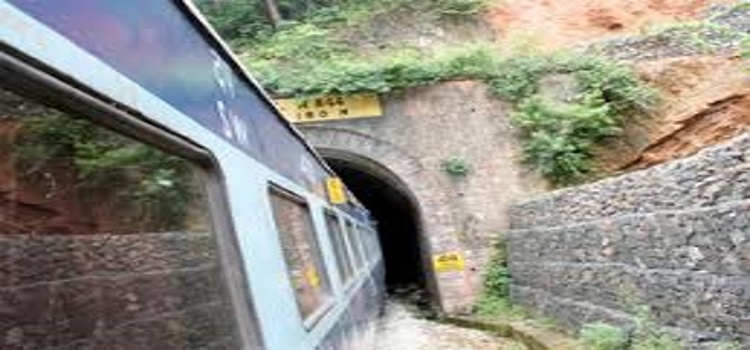
Moving beyond the five hill networks that are major tourist attractions, Indian Railways is planning to also preserve its old five-metre gauge tracks built during its early days in the British era to promote heritage tourism.
These corridors in Madhya Pradesh, Rajasthan, Gujarat, Assam and UP are currently defunct.
“As part of the strategy to preserve the metre-gauge lines, Indian Railways is planning to preserve few metre-gauge lines, which have the potential to attract more tourists,” a senior Railway Ministry official told, requesting anonymity.
“The decision to preserve the metre-gauge lines was taken at a meeting on February 3. Railway Board Chairman Ashwani Lohani, stressing on the need to preserve the metre-gauge lines to promote the heritage structures of Indian Railways, asked the officials to identify such railway tracks on which the tourism can be promoted,” the official said.
While the rail corridor in UP passes through Dudhwa tiger reserve; the rail line in Madhya Pradesh runs through the scenic Vindhyachal range of mountains. Recently, railways have also planned running air conditioned trains on mountain railways in Darjeeling, Nilgiri and Shimla, apart from reviving the vintage steam locomotives to haul the iconic Palace on Wheels.
“Thus we have identified five lines for preservation — the 42.27 km Visavadar-Talala line in Gujarat, the 16 km Mhow-Patalpani-Kalakand line in Madhya Pradesh, the 162 km Mavli Junction-Marwar Junction line in Rajasthan, the 171 km Nanpur-Mailani line in Uttar Pradesh and the 47 km Mahur-Harangjao metre-gauge line in Assam,” he said.
“Four of the metre-gauge lines are in working condition, while the one line located in Assam is not operational right now,” he added.
The official also said that the Railway Ministry has written to the zonal railways to check the operational feasibility of these tracks. “Once the response from zonal railways is received by the third week of April, the ministry will formally launch the project,” he said.
Giving details of some of the five lines, the official said: “The Visavadar-Talala metre-gauge line passes through the Gir forest in Gujarat and there is thus a speed restriction. Currently, only three trains pass through this section in the day.”
The Mhow-Patalpani-Kalakund line, the official said, passes through picturesque mountains, valleys, tunnels, ravines and crosses the Choral and Malendi rivers, which makes the journey very memorable, especially after the rains.
According to the official, this line was laid by the British about 150 years ago and passes through of the Vindhyachal mountain range.
The official said that the Nanpur-Mailani metre-gauge railway track in Uttar Pradesh crosses through the Dudhwa Tiger reserve.
The Railways currently operates six trains on the section. The trains are allowed to run at a maximum speed of 30 km per hour, which reduces to 20 km per hour in accident-prone areas.
The British laid this track in the 19th century for transporting timber from Nepal’s forests and from the forests on the border.
Currently, the five hill trains — Darjeeling Himalayan train, Nilgiri Mountain Railway, Kalka-Shimla Railway, Kangra Valley Railway and Matheran Hill Railway — are a major attraction for tourists in India.
Also, the railway ministry is working to revive two defunct heritage locomotives, including a fireless steam loco which is rested at the national rail museum in the national capital. According to a railway board official, the ministry has decided to preserve five of its metre-gauge lines across the country, and run them as heritage lines.
Earlier, it was planned to convert them into broad-gauge lines as they were lying defunct. Sources said these lines are linked to tourist destinations and were earlier identified for gauge conversion, but now will be retained as heritage lines.
Among the identified corridors are the 30-km long Mhow-Kalakund rail line in Madhya Pradesh, which, the sources said, will be used solely for tourism purposes. This rail route passes through the picturesque hills and the valleys of the Vindhyachal mountain range and will draw tourists to the Patalpani waterfall, officials said.
Similarly, the 171-km Nanpara-Mailani section in Uttar Pradesh, too, will be developed for tourist purposes. The corridor runs through the Dudhwa national park which attracts a large number of wildlife enthusiasts.
Around a 50-km meter-gauge line that passes through the Gir Forest in Gujarat will also be preserved, sources said, along with about a 70-km Marwar-Udaipur metre-gauge railway section falling in the bio-diversity sanctuary of Todgarh Raoli. “These are picturesque stretches which can be enjoyed by tourists and are unique to India. They have high potential of ecotourism safari. All these sections have sharp bends and tunnels which have immense tourism potential,” said an official.
Sources say that the ministry is also contemplating if these heritage trains can be such that tourists can enjoy the scenery through large glass windows and ceilings like the trains started in Araku valley and the Kashmir valley. Railway ministry has also identified a 120-km section in Assam – the Mahur Harangajao meter gauge – in the hill section of the North Cachar Hill district (now called Dima Hasao district). The line, which will now be preserved, is unique for the presence of several tunnels in the section that still stand out as architectural marvels. Three of the hill railways- the Darjeeling Himalayan, the Nilgiri Mountain, and the Kalka-Shimla Railway- have been accorded the UNESCO World Heritage status, two other hill railways – the Neral-Matheran and the Kangra Valley, is on a tentative list of the UNESCO World Heritage Sites.
